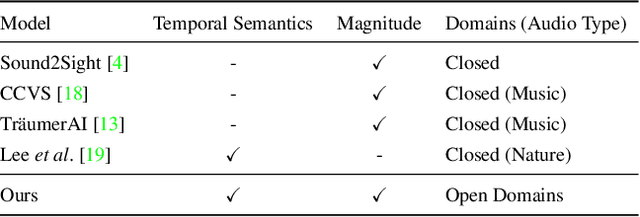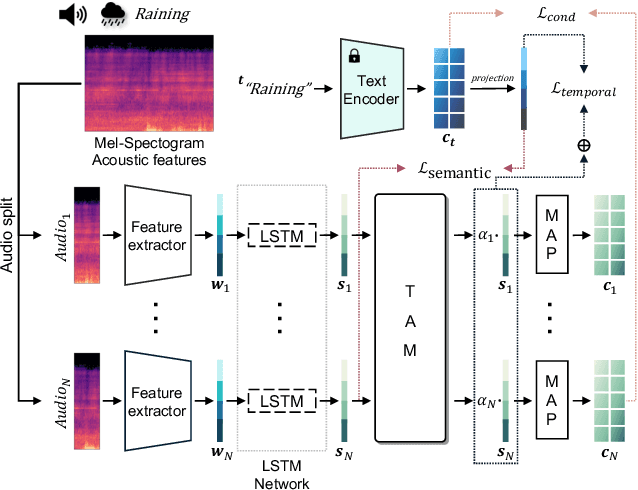Yujin Jeong
Read, Watch and Scream! Sound Generation from Text and Video
Jul 08, 2024



Abstract:Multimodal generative models have shown impressive advances with the help of powerful diffusion models. Despite the progress, generating sound solely from text poses challenges in ensuring comprehensive scene depiction and temporal alignment. Meanwhile, video-to-sound generation limits the flexibility to prioritize sound synthesis for specific objects within the scene. To tackle these challenges, we propose a novel video-and-text-to-sound generation method, called ReWaS, where video serves as a conditional control for a text-to-audio generation model. Our method estimates the structural information of audio (namely, energy) from the video while receiving key content cues from a user prompt. We employ a well-performing text-to-sound model to consolidate the video control, which is much more efficient for training multimodal diffusion models with massive triplet-paired (audio-video-text) data. In addition, by separating the generative components of audio, it becomes a more flexible system that allows users to freely adjust the energy, surrounding environment, and primary sound source according to their preferences. Experimental results demonstrate that our method shows superiority in terms of quality, controllability, and training efficiency. Our demo is available at https://naver-ai.github.io/rewas
The Power of Sound : Audio Reactive Video Generation with Stable Diffusion
Sep 08, 2023



Abstract:In recent years, video generation has become a prominent generative tool and has drawn significant attention. However, there is little consideration in audio-to-video generation, though audio contains unique qualities like temporal semantics and magnitude. Hence, we propose The Power of Sound (TPoS) model to incorporate audio input that includes both changeable temporal semantics and magnitude. To generate video frames, TPoS utilizes a latent stable diffusion model with textual semantic information, which is then guided by the sequential audio embedding from our pretrained Audio Encoder. As a result, this method produces audio reactive video contents. We demonstrate the effectiveness of TPoS across various tasks and compare its results with current state-of-the-art techniques in the field of audio-to-video generation. More examples are available at https://ku-vai.github.io/TPoS/
Zero-shot Visual Commonsense Immorality Prediction
Nov 10, 2022



Abstract:Artificial intelligence is currently powering diverse real-world applications. These applications have shown promising performance, but raise complicated ethical issues, i.e. how to embed ethics to make AI applications behave morally. One way toward moral AI systems is by imitating human prosocial behavior and encouraging some form of good behavior in systems. However, learning such normative ethics (especially from images) is challenging mainly due to a lack of data and labeling complexity. Here, we propose a model that predicts visual commonsense immorality in a zero-shot manner. We train our model with an ETHICS dataset (a pair of text and morality annotation) via a CLIP-based image-text joint embedding. In a testing phase, the immorality of an unseen image is predicted. We evaluate our model with existing moral/immoral image datasets and show fair prediction performance consistent with human intuitions. Further, we create a visual commonsense immorality benchmark with more general and extensive immoral visual contents. Codes and dataset are available at https://github.com/ku-vai/Zero-shot-Visual-Commonsense-Immorality-Prediction. Note that this paper might contain images and descriptions that are offensive in nature.
 Add to Chrome
Add to Chrome Add to Firefox
Add to Firefox Add to Edge
Add to Edge